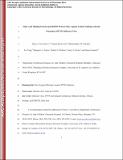Sialic acid-binding protein Sp2CBMTD protects mice against lethal challenge with emerging influenza A (H7N9) virus
Abstract
Compounds that target the cellular factors essential for influenza virus replication represent an innovative approach to antiviral therapy. Sp2CBMTD is a genetically engineered multivalent protein that masks sialic acid-containing cellular receptors on the respiratory epithelium, which are recognized by influenza viruses. Here, we evaluated the antiviral potential of Sp2CBMTD against lethal infection in mice with an emerging A/Anhui/1/2013 (H7N9) influenza virus and addressed the mechanistic basis of its activity in vivo. Sp2CBMTD was administered to mice intranasally as a single or repeated dose (0.1, 1, 10, or 100 μg) before (day −7, −3, and/or −1) or after (6 or 24 h) H7N9 virus inoculation. A single Sp2CBMTD dose (10 or 100 μg) protected 80% to 100% of the mice when administered 7 days before the H7N9 lethal challenge. Repeated Sp2CBMTD administration conferred the highest protection, resulting in 100% survival of the mice even at the lowest dose tested (0.1 μg). When treatment began 24 h after exposure to the H7N9 virus, a single administration of 100 μg of Sp2CBMTD protected 40% of the mice from death. The administration of Sp2CBMTD induced the pulmonary expression of proinflammatory mediators (interleukin-6 [IL-6], IL-1β, RANTES, monocyte chemotactic protein-1 [MCP-1], macrophage inflammatory protein-1α [MIP-1α], and inducible protein [IP-10]) and recruited neutrophils to the respiratory tract before H7N9 virus infection, which resulted in less pronounced inflammation and rapid virus clearance from mouse lungs. Sp2CBMTD administration did not affect the virus-specific adaptive immune response, which was sufficient to protect against reinfection with a higher dose of homologous H7N9 virus or heterologous H5N1 virus. Thus, Sp2CBMTD was effective in preventing H7N9 infections in a lethal mouse model and holds promise as a prophylaxis option against zoonotic influenza viruses.
Citation
Govorkova , E A , Baranovich , T , Marathe , B M , Yang , L , Taylor , M A , Webster , R G , Taylor , G L & Connaris , H 2015 , ' Sialic acid-binding protein Sp2 CBMTD protects mice against lethal challenge with emerging influenza A (H7N9) virus ' , Antimicrobial Agents and Chemotherapy , vol. 59 , no. 3 , pp. 1495-1504 . https://doi.org/10.1128/AAC.04431-14
Publication
Antimicrobial Agents and Chemotherapy
Status
Peer reviewed
ISSN
0066-4804Type
Journal article
Description
This study was supported by the National Institute of Allergy and Infectious Diseases, National Institutes of Health, Department of Health and Human Services, under contract no. HHSN266200700005C and HHSN272201400006C, by the American Lebanese Syrian Associated Charities (ALSAC), and by the UK Medical Research Council Biomedical Catalyst grant MR/L012847/1.Collections
Items in the St Andrews Research Repository are protected by copyright, with all rights reserved, unless otherwise indicated.

